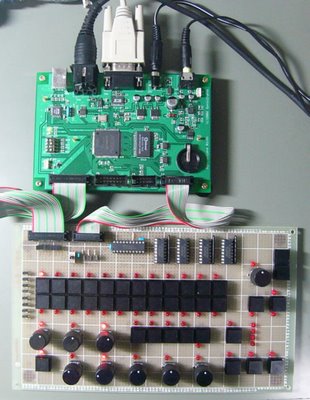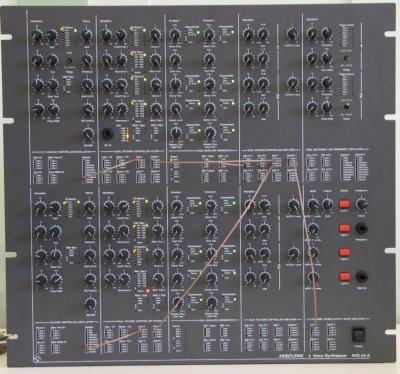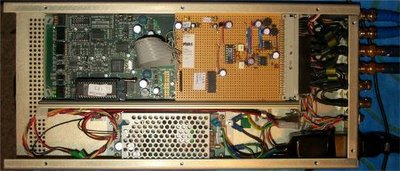
"This is a development system for audio applications of FPGAs and Microcontrollers. It provides the following features:
* NXP LPC2144 ARM Microcontroller with 128kB Flash, 16kB SRAM, USB, 2 ADCs, DAC, etc.
o Pin-compatible with LPC2146/LPC2148 for more SRAM and Flash
* MicroSD Flash card socket for on-board program, FPGA bitstream and data table storage.
* Xilinx XC3S250EVQ100-4 FPGA with ~250kgate capacity, 12 multipliers, 216kb RAM and 66 I/O
o Pin-compatible with XC3S500EVQ100-4 or -5 for more gates, BRAM, multipliers and speed
* ISSI IS61WV25616 SRAM with 4Mb (256k x 16) and 10ns access time.
o Pin-compatible with IS61WV51216 8Mb (512k x 16) for 2x capacity.
* Cirrus Logic CS4270 stereo audio CODEC with up to 200kHz / 24-bit sampling.
* 24.576MHz Oscillator
o Optional VCXO and simple PLL for sychronization to external sources.
* USB 2.2 full-speed port in Mini-B format.
* MIDI physical interface.
* Hitachi-standard character LCD drive signals.
* Off board analog/digital expansion port with 8 MCU I/O.
o Up to 6x 10-bit ADC inputs.
o 1x 10-bit DAC output.
o Up to 8x GPIO (4 with pullups for switches / encoders)
o 2nd UART
o Up to 3 PWM
* One Digilent-compatible 6-pin peripheral module connector for direct FPGA interfacing.
* JTAG ports for MCU and FPGA development and debugging
* USB or external 5V power.
* SMA Clock In/Out
* Uncommitted FPGA testpoints
I envision this being used for development of unique digital synthesis systems based on a hybrid of 32-bit ARM MCU acting as a powerful command interpreter and realtime scheduler, along with the FPGA/SRAM/CODEC which combine to provide a powerful audio synthesis and effects engine.
Potential applications include:
* MIDI-controlled digital synthesis
* Delay effects (more than 5 seconds of storage at 48kHz)
* Real-time spectral analysis with Xilinx FFT cores
* AES/EBU and SP/DIF interfacing (via Digilent port and VCXO)
* Vocoders
* Granular Synthesis
* etc"
schematics and more at
ARM FPGA Audio. Be sure to see the FPGA label below for other projects.
 A new DIY FPGA project by Eric Brombaugh. Click here for full details.
A new DIY FPGA project by Eric Brombaugh. Click here for full details.















































